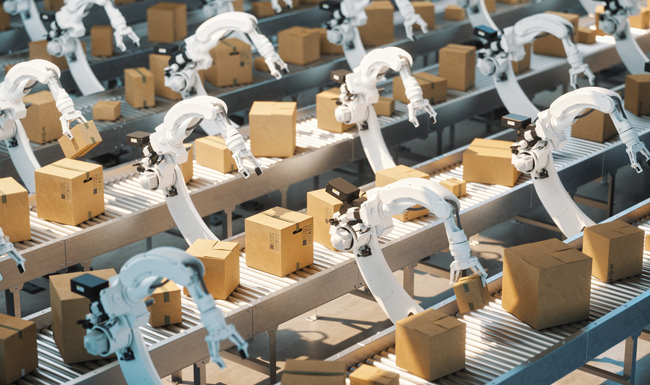
How Vendor Managed Inventory (VMI) Strengthens Supply Chain Resilience and Collaboration
To optimize inventory management, retailers and suppliers are increasingly turning to Vendor Managed Inventory (VMI) tools that transfer the responsibility…
Generix Ushers in a New Era of Intelligent Commerce for Retailers with AI-Driven Innovation Read the press release

Automation in supply chains has been transformational, and technology solutions are invaluable in streamlining processes and improving productivity and efficiency.
With automation already playing such a vital role in the supply chain, manufacturers embracing the available technologies, the idea of whether the supply chain industry could become fully automated is no longer the realm of fantasy.
However, while technology can do remarkable things, and has already transformed the supply chain, the human touch remains central to warehouse and transportation operations. Success for the future will be built on the synergy between the human workforce and automated systems, on augmenting people’s abilities with technology, and on using it to remove barriers, rather than on a complete technology revolution.
Automation delivers extraordinary benefits in the distribution center (DC) and throughout the supply chain. Warehouse management systems allow companies to maximize the use of space, optimize resources with ordered pick slots, boost receipts and returns with more efficient availability updates, and track and trace orders from start to finish. A more streamlined, productive, and efficient distribution center using a WMS delivers benefits across the whole supply chain.
However, supply chain success still relies on people. A fully automated warehouse would neglect the simple fact that the human touch remains vital to efficiency and success, and solutions that ignore this usually fail to deliver the operational effectiveness they are supposed to.
Automated systems, however sophisticated, don’t run themselves. They still require people to run them, to ensure that they talk to each other properly, and to solve problems when they don’t. Machine learning allows systems to learn and adapt, but in times of great change, human management and intervention is still indispensable.
The combination of people and technology is where automation and software-driven systems are most powerful. For example, powerful automated systems can help with traceability and recalls by rapidly identifying batches at fault. However, it is up to management to manage the process, execute the recall, and manage the company’s reputation with customers and buyers.
An automotive manufacturer struggled with manual data entry processes and paper trail. With a diverse client base, they needed flexibility in order to meet the needs and demands of their customers, while also needing a way to manage operations without expanding the workforce following rapid expansion of the business. By integrating SOLOCHAIN with their ERP, they were able to create a portal that enabled clients to manage their own orders. The WMS also automated processes, provided increased inventory visibility, and improved operations at the distribution center. By eliminating manual data entry, employees were able to be redeployed elsewhere to be used more effectively, and the time savings and improved efficiency meant that the team was able to build client loyalty and trust more easily.
It isn’t really all that shocking to discover that automation on its own is not the answer to supply chain success. Technological augmentation of the workforce is not designed to replace workers, but rather to act as a catalyst for greater efficiency and productivity, to allow humans to do more with less, and to reduce the number of speed bumps, hurdles, and roadblocks that get in the way.
Automation in the DC is all about taking tasks that are repetitive and simple, and handing them off to machines. Tasks that need a lot of time but little creativity or thought. Allowing technology to take care of these ‘robotic’ tasks (for want of a better word) improves productivity, efficiency, and speed, and most importantly enables staff members to apply themselves to tasks that are a better fit for their skills, and that require the human touch.
After all, there are limitations to the capabilities of machines and artificial intelligence. Take speeding up the workflow, for example. By just focusing on one element (the speed of certain systems), all you do is create bottlenecks in other areas of the process. If all the systems aren’t optimized, and if your workforce can’t keep up with the speed of one aspect of the process, by making one element faster you actually slow down the overall operation.
Similarly, you can automate all the processes you want, but if political decisions at a national level make them obsolete, or international events have a significant impact on the overall supply chain process, then humans are once again vital to designing and implementing a workaround.
Given Generix Group’s completeness of vision and ability to execute, SOLOCHAIN is well positioned to help companies needing a modern, flexible and agile solution that can easily adapt to their changing needs.
We invite you to contact us to learn more.

To optimize inventory management, retailers and suppliers are increasingly turning to Vendor Managed Inventory (VMI) tools that transfer the responsibility…

In an ever-evolving logistics environment, agile and precise warehouse resource management is essential to remain competitive. With increasing volumes driven…

France’s electronic invoicing reform relies on a Y-architecture, where Partner Dematerialization Providers (PDPs) play a central role in issuing and…

Work with our team to build your ideal supply chain software stack and tailor it to your unique business needs.